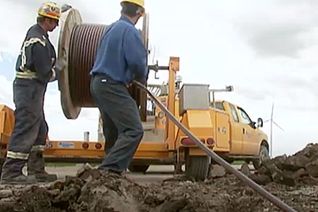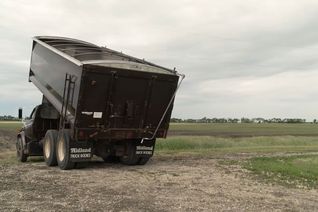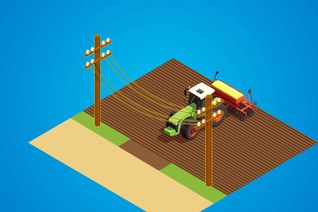Farm accidents can cause severe injuries or death, and damage to property and livestock. Know how tall your machinery is, and where the power lines are located in your yard and along the roads.

Avoid accidents with heavy machinery – always know where the power lines are.
Plan ahead for farm safety
- Always look up and check your clearance.
- Follow all restrictions when moving across natural gas pipelines.
- Apply for a clearance permit to move your building or oversized structure on an approved route.
- Ensure overhead power lines on your property and near field entrances are high enough to safely clear your machinery.
- Apply for a free annual permit to drive or tow farm equipment higher than 4.8 metres along an approved route.
- Lower truck boxes, tractor loaders, and other equipment before you drive away.
- Always disconnect the circuit before working on electrical equipment.
- Identify hazards and share safety plans with your employees.

Farm Safety Programs
For safety around power lines obtain a clearance permit for large equipment. Consider burying overhead power lines in your farm yard.
Video: 1:02
Plan a safe farm yard for you, your family, and your employees
- Locate barns, sheds, granaries, propane and fuel tanks at least 9 metres from overhead power lines.
- When building new bins, plan traffic movement so that it does not go under overhead lines.
- Plant tall-growing trees at least 9 metres to the side of overhead power lines.
Call us at 1-888-624-9376 (1-888-MBHYDRO) if you need power lines moved.

Your safety watch: Farm tech impacts
Farm equipment has gotten bigger and bigger over the years — that’s why it’s so important to be safe around power lines and Manitoba Hydro infrastructure. Watch this video to learn the best way to keep you and your equipment out of harm’s way on the farm.
Video: 1:00

Farm safety around power lines
Watch to learn how to be safe around power lines on your farm.
Video: 2:27
Bury overhead power lines
If your farm yard has overhead power lines, consider burying them to:
- Eliminate the danger of farm equipment coming in contact with them.
- Prevent downed lines during storms.
- Improve the appearance of your farm yard.
We will cover a portion of the costs to bury the primary line in your farm yard. The program may cover:
- 50% of installation costs up to a maximum of $10,000 to bury existing overhead power lines.
- 25% of total costs up to a maximum of $10,000 for new construction.
For a cost estimate, contact your Customer Service Centre, or apply online to change your electrical service.
Overhead power line crossing upgrades for agricultural equipment
If your approaches or routing to your agricultural farmland have overhead power lines, you may benefit from crossing upgrades. Overhead power line crossing upgrades can:
- Eliminate the danger of farm equipment contacting overhead power lines.
- Avoid unnecessary damages to farm equipment and Manitoba Hydro infrastructure.
We may compensate a portion of the cost to raise the height of overhead power lines that cross provincial/municipal roads and approaches into fields:
- 50% discount on upgrading existing overhead crossings up to a maximum of $10,000. We will review multiple approaches to a ¼ section of land based on accessibility to all location of the agricultural land (river, creek, low areas, etc.).
- We will review overhead crossings that are on provincial or municipal roads for a discount of up to a maximum of $3,000 per crossing to a maximum of $10,000 per customer. This would apply to overhead crossings less than 6.7m (22’).
For a cost estimate, contact your Customer Service Centre and apply for your Farm equipment clearance permit.
Electrically heated livestock waterers
If your waterer develops an electrical fault, your animals may get an uncomfortable shock that prevents them from getting enough water.
- Inspect your waterer carefully before you turn it on for the winter.
- Check all connections for damaged or frayed conductors, and clean up corroded connections with a wire brush.
- Follow the waterer manufacturer’s installation, operating, and maintenance instructions to protect you and your animals from electric shock.
Grass and stubble fires
Every year, uncontrolled stubble fires damage power lines and poles.
These fires may cause outages that leave people without electricity for hours and put people on life support at risk.
- As a landowner, you are responsible for the cost of repairing or replacing damaged poles caused by your grass fire.
- Before you start a burn this year, have your safety precautions in place. Install fireguards to protect utility poles and closely monitor your burn.
- Check with your municipality for current burning restrictions. See more information on the Province of Manitoba’s Controlled Crop Residue Burning Program website.
Fallen poles and power lines are extremely dangerous and should be reported immediately to 911 or your local emergency services.
